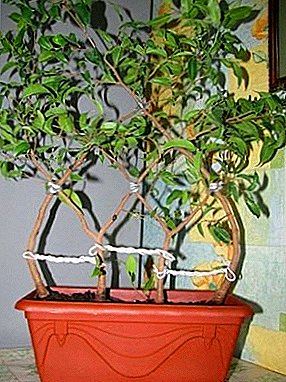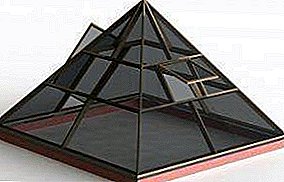
According to legend, it is under this durable, extremely viable tree with the botanical name Ficus religious (Ficus religiosa) Indian prince Siddhartha gained enlightenment and became the Buddha - the founder of the oldest world religion.
In room culture sacred ficus "Eden" willingly grows in warm rooms
develops a strong trunk with greyish bark,
strong branches and dense green heart-shaped leaves with a characteristic elongated tip.
The craftsmen form from it a bonsai tree of spectacular, powerful form.
Home care
Lighting
Distributed, but sufficiently bright light, which provides windows facing east or west, is preferred.
During the "summer holidays" in the open air balcony or plot you need to take care that the tree does not burn direct sunlight.
Temperature
The best summer temperature range - from 20 to 25 degrees; winter temperature should not be below 15 degrees.
Attention: Draft contraindicated.
Priming
The optimal soil substrate should be slightly acidic or neutral, quite loose and nutritious.
You can use ready-made soil for ficuses, or mix two parts of sod and leafy soil with one part of coarse sand.
Recommend and this composition:
- sod;
- leafy;
- peat land with sand;
- all ingredients in equal quantity.
Landing
 The container for landing can be a standard form: (vertical size is from a quarter to a third of the height of the plant), with a mandatory drainage hole.
The container for landing can be a standard form: (vertical size is from a quarter to a third of the height of the plant), with a mandatory drainage hole.
Since the stagnation of water is extremely unfavorable, it is better to choose a porous material - a ceramic without a continuous layer of glaze.
At the bottom of the container must have a drainage layer of small pebbles or expanded clay.
During planting, as the soil is filled up, when filling in the voids between the roots, care must be taken not to deepen the root neck of the plant: it must be flush with the ground.
If the plant is high, you need to take care of support for its trunk.
After planting ficus should be watered.
Transfer
Young plants are transplanted annually, and mature specimens - every few years, and a signal to transplant is a complete interweaving of an earthy coma with roots.
Too spacious containers are undesirable: for young rubber figs, the diameter of the new pot should be 2cm more former, for mature - on 6cm.
Watering
Ficus religious is watered twice a week. well-settled, soft water, avoiding stagnant moisture.
Surplus irrigation water that accumulates in the pan, immediately drained.
If necessary, on hot summer days, the frequency of watering increases, but the top layer of the earth should dry out a little before the next intake of moisture.
Air humidity
It is necessary to maintain high humidity, resembling the native land of this plant in India.
Mandatory daily spraying with soft water at room temperature
Top dressing
From spring to autumn, one or two times a month, additional fertilizing is carried out with mineral and organic components, while providing a high content of nitrogen and potassium.
If wintering is warm, feeding is not stopped.
With a cool and bright content in the winter feed less often.
Growth and pruning
In room culture grows up to 2-3 meters with the potential ability to reach multimeter height.
Important: Forming pruning is necessary to limit growth and create a beautiful crown.
Pruned young shoots in early spring, before the start of active growing season; in addition, as they grow, they pinch the tips of the growing branches in order to stimulate the development of a thicker crown.
An interesting result is obtained by braiding into the "pigtail" the trunks of several young plants planted in one container.
In general, due to its rapid growth and pronounced plasticity of young stems and shoots, religious ficus is an excellent candidate for creating spectacular half-meter bonsai trees using the whole arsenal of devices: interchangeable wire cages, target pruning, tension support systems.
A photo
In the photo ficus sacred "Eden":





Breeding
The sacral ficus can breed by cuttings and seeds.
Reproduction by cuttings
For such reproduction, stem cuttings of approximately fifteen centimeter length, with several leaves, are used.
The lower sections of the cuttings are treated with a root formation stimulator and rooted in the soil substrate from equal amounts of pearlite, or coarse sand and peat, covered with plastic wrap.
After the formation of the roots and the emergence of new shoots (about a month, sometimes earlier) the cuttings are seated in separate containers with the usual soil mixture for ficuses.
Seed propagation
This method is widely used for home cultivation. "the sacred tree of the Buddha", and the seeds with good germination are sent by mail.
Before sowing, seeds are soaked in a growth stimulator solution, and then sown on the surface of a light loose soil mixture.
Cover with plastic film sowing and put in a warm, well-lit place, air and maintain the substrate in a moist condition.
Shoots appear, usually in a week.
As they grow, the seedlings dive and then sit in separate containers.
Diseases and pests
Ficus "Eden" drops the leaves - The result of frequent changes, not enough moist air, drafts and temperature fluctuations.
The same can be observed in a newly purchased plant that is experiencing stress due to a sharp change in conditions of detention.
Therefore, insufficient watering and spraying is the “Start” button for dropping the crown.
 Mistakes of care, above all, the stagnation of moisture, lead to the weakening of the plant and the defeat of his fungal infections. In this case, you need to optimize watering and process ficus fungicides.
Mistakes of care, above all, the stagnation of moisture, lead to the weakening of the plant and the defeat of his fungal infections. In this case, you need to optimize watering and process ficus fungicides.
When there is not enough moist air on the sacred ficus, the aphid settles.
Besides his can attack mealybug, thrips and scytwick.
As a first measure, apply the treatment of affected parts of the plant with soapy water, but The most effective remedy for pests is systemic insecticides.
Ficus sacred eden - easy to keep at home plant.
Temperature below 15 degrees, the absence of scorching sun, frequent movements and drafts, sufficient watering, regular spraying - and the Buddhist "Bodhi tree" will develop well, and in addition, actively purify the air from xylene and toluene.
Purposeful pruning and the formation of plastic seedlings can turn this, in itself a landmark and viable, plant into spectacular interior decoration.












